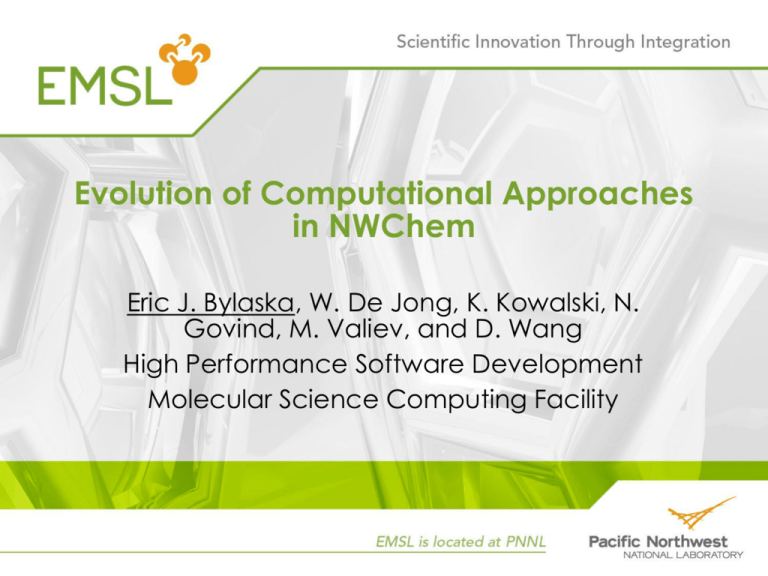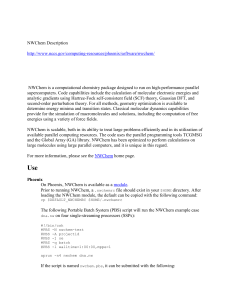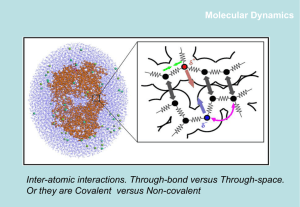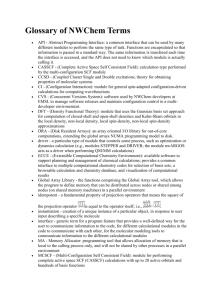Evolution of Computational Approaches in NWChem
advertisement

Evolution of Computational Approaches
in NWChem
Eric J. Bylaska, W. De Jong, K. Kowalski, N.
Govind, M. Valiev, and D. Wang
High Performance Software Development
Molecular Science Computing Facility
Outline
Overview of the capabilities of NWChem
Existing terascalepetascale simulations in
NWChem
Challenges with developing massively
parallel algorithm (that work)
Using embeddable languages (Python) to
develop multifaceted simulations
Summary
Overview of NWChem: Background
NWChem is part of the Molecular Science Software
Suite
Developed as part of the construction of EMSL
Environmental Molecular Sciences Laboratory, a DOE BER
user facility, located at PNNL
Designed and developed to be a highly efficient
and portable Massively Parallel computational
chemistry package
Provides computational chemistry solutions that are
scalable with respect to chemical system size as well
as MPP hardware size
Overview of NWChem: Background
More than 2,000,000 lines of code (mostly FORTRAN)
About half of it computer generated (Tensor Contraction Engine)
A new version is released on a yearly basis:
Addition of new modules and bug fixes
Ported the software to new hardware
Increased performances (serial & parallel)
Freely available after signing a user agreement
World-wide distribution (downloaded by 1900+ groups)
70% is academia, rest government labs and industry
Overview of NWChem: Available on many
compute platforms
Originally designed for parallel architectures
Scalability to 1000’s of processors (part even 10,000’s)
NWChem performs well on small compute
clusters
Portable – runs on a wide range of computers
Supercomputer to Mac or PC with Windows
Including Cray XT4, IBM BlueGene
Various operating systems, interconnects, CPUs
Emphasis on modularity and portability
Overview of NWChem: capabilities
NWChem brings a full suite of methodologies to solve
large scientific problems
High accuracy methods (MP2/CC/CI)
Gaussian based density functional theory
Plane wave based density functional theory
Molecular dynamics (including QMD)
Will not list those things standard in most
computational chemistry codes
Brochure with detailed listing available
http://www.emsl.pnl.gov/docs/nwchem/nwchem.html
Overview of NWChem: high accuracy
methods
Coupled Cluster
Closed shell coupled cluster [CCSD
and CCSD(T)]
Tensor contraction engine (TCE)
Spin-orbital formalism with RHF,
ROHF, UHF reference
CCD, CCSDTQ, CCSD(T)/[T]/t/…,
LCCD, LCCSD
CR-CCSD(T), LR-CCSD(T)
Multireference CC (available
soon)EOM-CCSDTQ for excited
states
MBPT(2-4), CISDTQ, QCISD
8-water cluster on EMSL computer:
1376 bf, 32 elec, 1840 processors
achieves 63% of 11 TFlops
CF3CHFO CCSD(T) with TCE:
606 bf, 57 electrons, open-shell
Overview of NWChem: Latest capabilities of
high accuracy
Gas phase
CR-EOMCCSD(T)
DNA
environment
n *
4.76
n *
*
5.24
*
5.01
5.79
TDDFT infty 5.81 eV
EOMCCSD infty 6.38 eV
Surface Exciton Energy: 6.35 +/- 0.10 eV (expt)
Dipole polarizabilities (in Å3)
C60 molecule in ZM3POL basis set:
1080 basis set functions; 24 correlated
Electrons; 1.5 billion of T2 amplitudes;
240 correlated electrons
Wavelength
CC2
CCSD
Expt.
92.33
82.20
76.5±8
1064
94.77
83.62
79±4
532
88.62
NWChem capabilities: DFT
Density functional theory
Wide range of local and non-local
exchange-correlation functionals
Truhlar’s M05, M06 (Yan Zhao)
Hartree-Fock exchange
Meta-GGA functionals
Self interaction correction (SIC) and
OEP
Spin-orbit DFT
ECP, ZORA, DK
Constrained DFT
Implemented by Qin Wu and Van
Voorhis
DFT performance: Si75O148H66,
3554 bf, 2300 elec, Coulomb fitting
Overview of NWChem: TDDFT
Density functional theory
TDDFT for excited states
Expt: 696 nm ; TDDFT: 730 nm
Expt: 539 nm ; TDDFT: 572 nm
Modeling the λmax (absorption maximum) optical chromophores with dicyanovinyl and
3-phenylioxazolone groups with TDDF, B3LYP, COSMO (8.93 → CH2Cl2), 6-31G**,
Andzelm (ARL), et al (in preparation 2008)
Development & validation of new Coulomb attenuated (LC) functionals
(Andzelm, Baer, Govind, in preparation 2008)
Overview of NWChem: plane wave DFT
Plane wave density functional theory
Gamma point pseudopotential and projector
augmented wave
Band structure (w/ spin orbit)
Extensive dynamics
functionality with Car-Parrinello
CPMD/MM molecular dynamics, e.g. SPC/E,
CLAYFF, solid state MD
Various exchange-correlation
functionals
LDA, PBE96, PBE0,(B3LYP)
Spin-Orbit splitting in GaAs
Exact exchange
SIC and OEP
Can handle charged systems
A full range of
pseudopotentials and a
pseudopotential generator
A choice of state-of-the-art
minimizers
Silica/Water CPMD
Simulation
CCl42-/water
CPMD/MM Simulation
Overview of NWChem: classical molecular
dynamics
Molecular dynamics
Charm and Amber force fields
Various types of simulations:
Energy minimization
Molecular dynamics
simulation including ab initio
dynamics
Free energy calculation
Multiconfiguration
thermodynamic integration
Electron transfer through proton
hopping (Q-HOP), i.e. semi-QM in
classical MD
Implemented by Volkhard group,
University of Saarland, Germany
Set up and analyze runs with Ecce
Overview of NWChem: QM/MM
MM
Seamless integration of molecular
dynamics with coupled cluster and
DFT
QM
QM/MM
Optimization and transition state
search
QM/MM Potential of Mean Force
(PMF)
Modeling properties at finite
temperature
Excited States with EOM-CC
Polarizabilities with linear
response CC
NMR chemical shift with DFT
QM/MM CR-EOM-CCSD Excited
State Calculations of cytosine base
in DNA, Valiev et al., JCP 125
(2006)
Overview of NWChem: Miscellaneous
functionality
Other functionality available in NWChem
Electron transfer
Vibrational SCF and DFT for anharmonicity
COSMO
ONIOM
Relativity through spin-orbit ECP, ZORA, and DK
NMR shielding and indirect spin-spin coupling
Interface with VENUS for chemical reaction dynamics
Interface with POLYRATE, Python
Existing TerascalePetascale capabilities
NWChem has several modules which are scaling to
the terascale and work is ongoing to approach the
petascale
NWPW scalability:
UO22++122H2O
(Ne=500, Ng=96x96x96)
MD scalability: Octanol
(216,000 atoms)
CCSD scalability: C60
1080 basis set functions
Speedup
1000
Cray T3E / 900
750
500
250
0
0
250
500
750 1000
Number of nodes
Existing terascalepetascale Capabilities:
Embarrassingly Parallel Algorithms
Some types of problems can be decomposed and executed in
parallel with virtually no need for tasks to share data. These types
of problems are often called embarrassingly parallel because
they are so straight-forward. Very little inter-task (or no)
communication is required.
Possible to use embeddable languages such as Python to
implement
Examples:
Computing Potential Energy Surfaces
Potential of Mean Force (PMF)
Monte-Carlo
QM/MM Free Energy Perturbation
Dynamics Nucleation Theory
Oniom
….
Challenges: Tackling Amdahl's Law
There is a limit to the performance gain
we can expect from parallelization
Parallel Efficiency
f
Ts
Np
Tp
1
1
f
Np
Np
1 f
f N p 100,
f N p
f N p
f N p
1
f N 1 f
p
Np
1 N p
f N p
My Program
Significant time investment for each
10-fold increase in parallelism!
99%
1000, 99.9%
10000, 99.99%
100, 0.9 99.8877666%
1000, 0.9 99.9888778%
1
2
1
2
1
2
f
1% * 24 hrs 14 min
0.1% * 24 hrs 1.4 min
0.01% * 24 hrs 8.64 sec
0.001122% * 24 hrs 1.62 min
0.000111222% * 24 hrs 9.6 sec
1-f
Challenges: Gustafson’s Law – make the
problem big
Gustafson's Law (also known as Gustafson-Barsis'
law) states that any sufficiently large problem can be
efficiently parallelized
My parallel Program
Tp (a(n) b(n))
Ts (a(n) P * b(n))
Assuming lim n a(n) small and a(n) b(n) 1
b(n)
Then S Ts ( a ( n) P * b( n)) a ( n) P * (1 a ( n))
Tp
(a (n) b(n))
1
P
1 a (n) * (1 )
a(n)
Challenges: Extending Time – Failure of
Gustafson’s Law?
The need for up-scaling in time is especially critical for classical
molecular dynamics simulations and ab-initio molecular dynamics,
where an up-scaling of about a 1000 times will be needed.
Current ab-initio molecular dynamics simulations done over several
months are currently done only over 10 to 100 picoseconds, and
the processes of interest are on the order of nanoseconds.
The step length in ab initio molecular dynamics simulation is on the
order of 0.1…0.2 fs/step
1 ns of simulation time 10,000,000 steps
at 1 second per step 115 days of computing time
At 10 seconds per step 3 years
At 30 seconds per step 9 years
Classical molecular dynamics simulations done over several
months, are only able simulate between 10 to 100 nanoseconds,
but many of the physical processes of interest are on the order of at
least a microsecond.
The step length in molecular dynamics simulation is on the order of 1…2
fs/step
1 us of simulation time 1,000,000,000 steps
at 0.01 second per step 115 days of computing time
At 0.1 seconds per step 3 years
At 1 seconds per step 30 years
Challenges: Need For Communication Tolerant
Algorithms
Speedup for Car-Parrinello Code
T3E
IBM-SP
70.00
speedup
60.00
50.00
40.00
30.00
20.00
10.00
0.00
0
10
20
30
40
50
60
70
Data motion costs increasing due to
“processor memory gap”
Coping strategies
Trade computation for communication
[SC03]
Overlap Computation and
Communication
number of nodes
5
10
Processor
4
10
1200
1100
1000
900
800
700
600
500
400
300
200
100
0
Performance
Time (s)
Scaling of local basis DFT
calculation
(55%/year)
3
10
Memory
[DRAM]
(7%/year)
2
10
1
10
8
16
32
64
Processors
96
128
0
10
1980
1985
1990
1995
Year
2000
2005
Basic Parallel Computing: tasks
Break program into tasks
A task is a coherent piece of work (such as Reading
data from keyboard or some part of a
computation), that is to be done sequentially; it can
not be further divided into other tasks and thus can
not be parallellised.
Basic Parallel Computing: Task
dependency graph
a = a + 2;
b = b + 3
A
2
B
3
C[0]
C[1]
C[2]
for i = 0..3 do
c[i+1] += c[i];
b = b * a;
b = b + c[4]
C[3]
C[4]
Basic Parallel Computing: Task
dependency graph (2)
Critical path
Synchronisation
points
Basic Parallel Computing: Critical path
The critical path determines the time required to
execute a program. No matter how many processors
are used, the time imposed by the critical path
determines an upper limit to performance.
The first step in developing a parallel algorithm is to
parallelize along the critical path
If not enough?
Case Study: Parallel Strategies for Plane-Wave Programs
....... N
e
Ng basis
Ne molecular orbitals
Critical path
Three parallization schemes
parallelization
Distribute basis
Distribute Molecular Orbitals
(i.e. FFT grid)
(one eigenvector per task)
FFT requires communication
<i|j> requires communication
Distribute Brillouin Zone
number of k-points is usually
small
proc=1
proc=2
proc=3
proc=....
• Minimal load
balancing
slab decomposition
Case Study: Speeding up plane-wave DFT
2+
Performance of UO2 +122water
Old parallel distribution
(scheme 3 – critical path)
10000
Norbitals
Ngrid
=N1xN2xN3
Time (Seconds)
Each box
represents
a cpu
1000
100
10
1
1
10
100
Number of CPUs
1000
10000
Case Study: Analyze the algorithm
Collect timings for important components of the
existing algorithm
Rotation Tasks
Overlap Task
Non-Local PSP Tasks
FFT Tasks
1000
10000
1000
1000
100
1000
100
100
10
100
10
10
1
10
1
1
0.1
1
0.1
0.1
0.01
0.01
0.1
1
10
100
1000
10000
1
10
100
1000
10000
0.01
1
10
100
1000
10000
1
10
100
1000
For bottlenecks
Remove all-to-all, log(P) global operations beyond 500 cpus
Overlap computation and communication (e.g. pipelining)
Duplicate the data?
Redistribute the data?
….
10000
Case Study: Try a new strategy
Old parallel distribution
New parallel distribution
Norbitals
Ngrid
=N1xN2xN3
Norbitals
Ngrid
=N1xN2xN3
Case Study: analyze new algorithm
Can trade efficiency in one component for
efficiency in another component if timings are of
different orders
1000
10000
nj=1
nj=2
nj=4
nj=8
nj=16
nj=32
nj=1
nj=2
nj=4
nj=8
nj=16
nj=32
100
10
1000
1000
nj=2
1000
nj=4
100
nj=2
100
nj=4
nj=2
nj=1
nj=4
nj=8
nj=8
nj=16
nj=16
nj=32
nj=32
10
10
1
1
0.1
1
0.1
0.1
0.01
0.1
10
100
1000
10000
0.01
10
100
1000
10000
nj=16
nj=32
10
1
nj=8
100
1
1
nj=1
nj=1
0.01
1
10
100
1000
10000
1
10
100
1000
10000
Case Study: Success!
Python Example: AIMD Simulation
title "propane aimd simulation"
start propane2-db
memory 600 mb
permanent_dir ./perm
scratch_dir ./perm
geometry
C
1.24480654 0.00000000 -0.25583795
C
0.00000000 0.00000000 0.58345271
H
1.27764005 -0.87801632 -0.90315343 mass 2.0
H
2.15111436 0.00000000 0.34795707 mass 2.0
H
1.27764005 0.87801632 -0.90315343 mass 2.0
H
0.00000000 -0.87115849 1.24301935 mass 2.0
H
0.00000000 0.87115849 1.24301935 mass 2.0
C
-1.24480654 0.00000000 -0.25583795
H
-2.15111436 0.00000000 0.34795707 mass 2.0
H
-1.27764005 -0.87801632 -0.90315343 mass 2.0
H
-1.27764005 0.87801632 -0.90315343 mass 2.0
end
basis
* library 3-21G
end
python
from nwmd import *
surface = nwmd_run('geometry','dft',10.0, 5000)
end
task python
Python Example: Header of nwmd.py
## import nwchem specific routines
from nwchem import *
## other libraries you might want to use
from math import *
from numpy import *
from numpy.linalg import *
from numpy.fft import *
import Gnuplot
####### basic rtdb routines to read and write coordinates ###########################
def geom_get_coords(name):
#
# This routine returns a list with the cartesian
# coordinates in atomic units for the geometry
# of given name
#
try:
actualname = rtdb_get(name)
except NWChemError:
actualname = name
coords = rtdb_get('geometry:' + actualname + ':coords')
return coords
def geom_set_coords(name,coords):
#
# This routine, given a list with the cartesian
# coordinates in atomic units set them in
# the geometry of given name.
#
try:
actualname = rtdb_get(name)
except NWChemError:
actualname = name
coords = list(coords)
rtdb_put('geometry:' + actualname + ':coords',coords)
Python Example: basic part of Verlet
loop
#do verlet step-1 verlet steps
for s in range(steps-1):
for i in range(nion3): rion0[i] = rion1[i]
for i in range(nion3): rion1[i] = rion2[i]
t += time_step
### set coordinates and calculate energy – nwchem specific ####
geom_set_coords(geometry_name,rion1)
(v,fion) = task_gradient(theory)
### verlet step ###
for i in range(nion3):
rion2[i] = 2.0*rion1[i] - rion0[i] - dti[i]*fion[i]
### calculate ke ###
vion1 = []
for i in range(nion3):
vion1.append(h*(rion2[i] - rion0[i]))
ke = 0.0
for i in range(nion3):
ke += 0.5*massi[i]*vion1[i]*vion1[i]
e = v + ke
print ' '
print '@@ %5d %9.1f %19.10e %19.10e %14.5e' % (s+2,t,e,v,ke)



